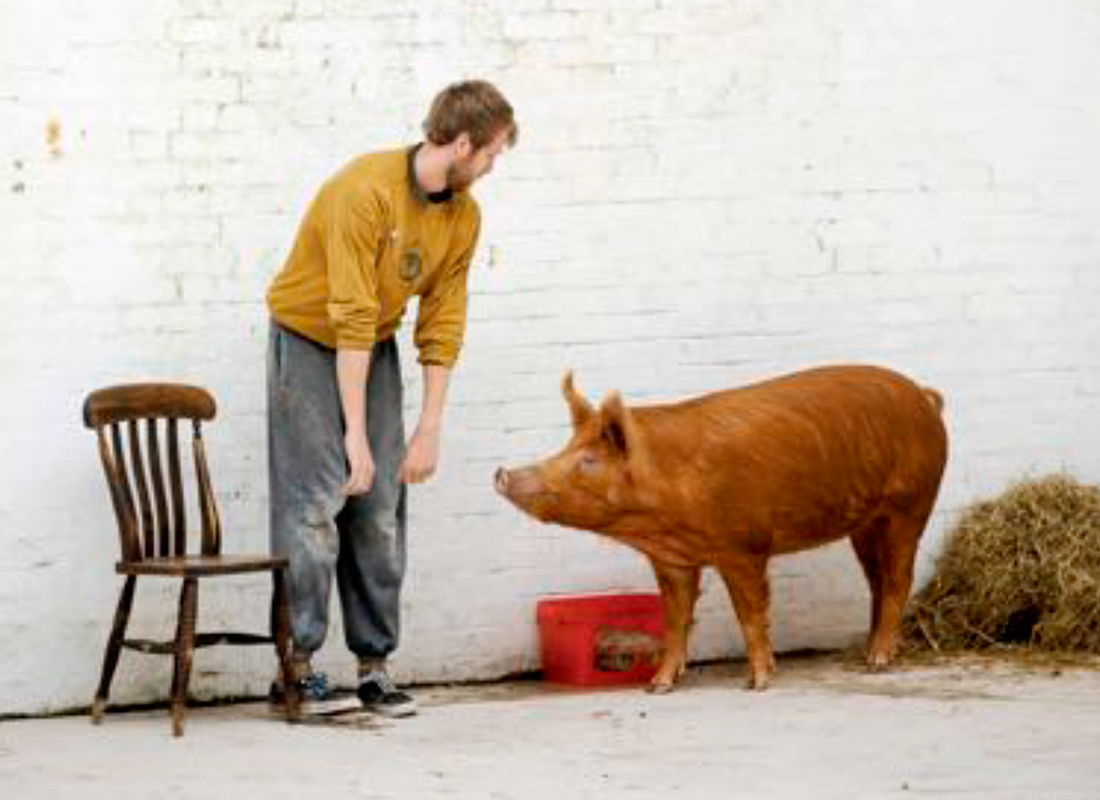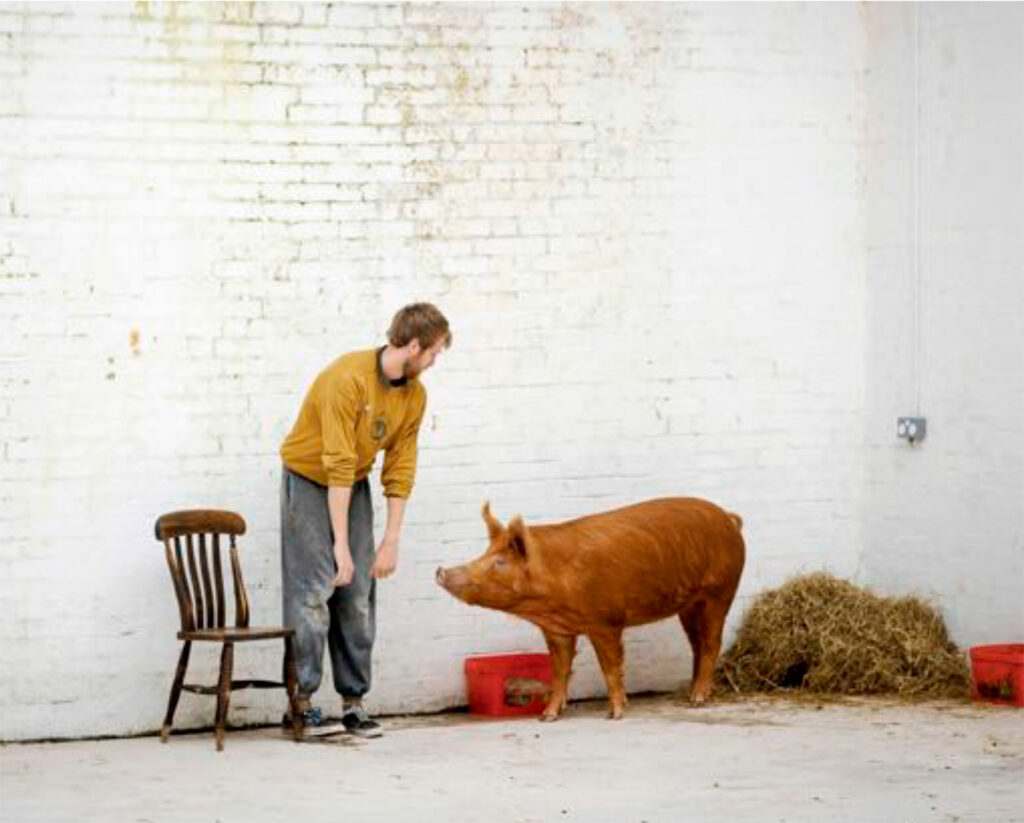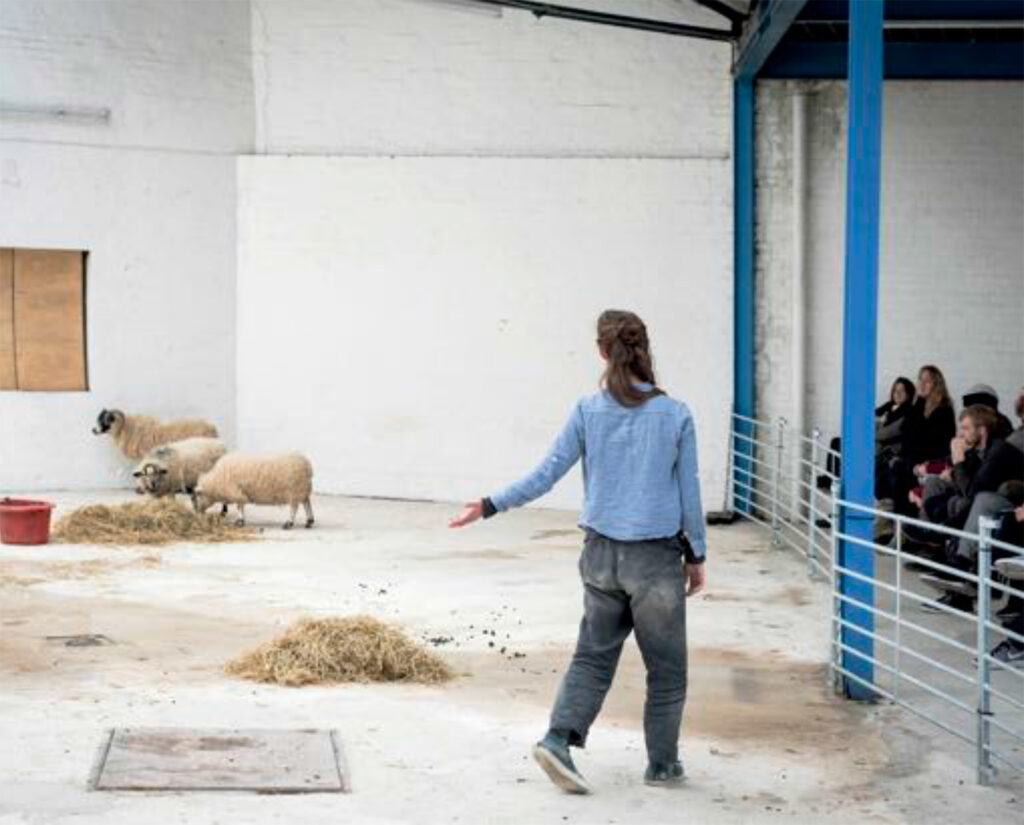Fevered Sleep’s Sheep Pig Goat
Last year, Sheep Pig Goat, the UK-based company Fevered Sleep’ project, was commissioned by the Wellcome Collection as part of their year-long Making Nature program, which explored the relationship between perception and knowledge in human-animal relationships, along with all the attendant issues of mastery, anthropomorphism and anthropocentrism that the human production of knowledge about animals inevitably raises. The company describes this as a ‘creative research studio:’ Sheep Pig Goat involved a weeklong public presentation of ‘a series of improvised encounters between human performers and animal spectators:’ specifically, some sheep, pigs and goats. Originally, the idea was to make a performance for an animal audience staged in the galleries at the Wellcome. But gradually the company moved away from this towards plans for a project that would offer human visitors what director, David Harradine describes as a space in which to “properly, respectfully and carefully observe animals watching a performance and reflect and report back on what they’ve seen, whether it’s the body language of a pig or a goat.”1 For Harradine, “humans do a really bad job of paying attention,’ and so the project was conceived of as giving both the company and a wider public the opportunity to attend to animals, but also to attend to animals as they themselves engaged in processes of attending, rather than being mere objects of human observation.”2
In 1996, Harradine and co-artistic director, Sam Butler founded Fevered Sleep, and have created over 20 different projects of which Sheep Pig Goat is not the first to engage with animality. For instance, the 2008 performance, An Infinite Line: Brighton was “an exploration of and response to the quality of natural light in Brighton,” and featured a white spotted stallion, Phoenix.3 But whilst the live horse that appeared in this early work was arguably there as a kind of ‘stand-in’—a metaphor for the extraordinary indifference of the natural phenomena that the performance hoped to be ‘about’—the animals in Sheep Pig Goat seem to move well beyond operating as mere vehicles for human expression.4
The first iteration of the project took place in March 2017, in a London warehouse trying to be ‘as barn-like as possible.’ The animals involved were ‘selected for their familiarity with human contact’ and were transported to the site from a farm in Wales, along with their handlers, who ‘advised on and supervised all aspects of the animals’ participation in the project’ and were present for all of the encounters, having the principle function of attending to the animals’ welfare. The animals included two female Tamworth pigs that their handlers keep for breeding, and a group of four rescued goats—all adolescent males. The human performers were two dancers, a vocalist and two other musicians whom the directors described as offering them a kind of ‘toolbox’ for the unknown requirements of the work to come: all expert improvisers, all expert non-verbal conversationalists that the directors value for their heightened competencies in relational attentiveness.
The project was framed as a use of performance to investigate a series of questions, including “how well do humans see animals as they really are—not as we tell ourselves they are?” And “what do animals perceive, when they see us?” But even more interesting than this, I think, are the ways in which questions were a key part of how the encounters were structured. For Harradine, his and Butler’s role in the project as co-directors was “to create frameworks for the encounters, and to set tasks or targets for the performers, in an open-ended, non-directed way, through questions. What happens if…? Can you see how…? Is there any…? Could you…?” But then ultimately, and crucially, he suggests, “It is the animals who direct us to ‘direct’ the performers.”5 In this scenario, then, it is not just the artist-researcher who might be posing the questions that guide the research. Rather, we also need to consider what questions the animals might have been posing—what questions did the sheep, pigs and goats have about the behaviour of these creatures with whom they found themselves sharing space and time? If current conventions mean that Sheep Pig Goat can be straightforwardly recognized as ‘practice as research’ because it asks questions; then the reason why it is pertinent research is that it is also an exercise in trying to ask animals the right questions—ones that allow them to speak, rather than ones that silence or predetermine answers in advance, circularly. Not, yes/no questions like: “Can animals perform? Can a goat dance? Are animals capable of the kinds of deliberate, conscious, chosen activity that would allow us to grant them the status of genuine performers?” But “and-and” questions like: “how can we hear the animals questions?” And “how might animals change our very idea of questioning itself?” In this sense, we might suggest that the project is not a ‘use’ or application of performance for animal research, so much as a kind of animalizing of both performance and research.
So, what happened during Sheep Pig Goat? “Very little happened actually,” Butler says. And she is right, there was something of the self-reflexive humour of failure we find in Marcus Coates work here too—a wry smile as we catch a glimpse of our own desperation for contact with an other who appears more interested in what there might be to eat, and in her fellow pig, than with anything a human might be doing. The animals in Sheep Pig Goat were invited to be observers of the human performers ‘on their own terms:’ an invitation that they often appeared to take up precisely by largely ignoring them. But if from one perspective “very little happened,” a lot also happened. And indeed, this is because such a multiplicity of happenings took place, that no single response has the power to sanction the meaning of the event as a whole. When we ask, “What happened?” the response must take the form of an addition rather than a reduction. And-and.
What happened? Sheep Pig Goat was a demonstration of the performance’s epistemic force, a project that foregrounds performance as a mode of inquiry. But it was also a project from which the directors emerged speaking not of a “contribution to knowledge” but of an “abyss of ignorance.” It was a site of learning; but it was also one of unlearning. Although, perhaps, having exited the paradigm of mastery, there is no reason why research might not be defined—as Vinciane Despret suggests—as aiming to make the world more rather than less strange to us. From this perspective, Sheep Pig Goat appears as one way to respond to Despret’s call “to learn to encounter animals as if they were strangers, so as to unlearn all of the idiotic assumptions that have been made about them.”6
What happened? There is the difference between what happened to/for the performers who were there with the animals every day, unlike most of the visitors who, for the most part, only observed a single encounter. In this context, for instance, the singer described what was for her ‘a moment of sheer accomplishment’—likely unnoticed by most of the visitors—when the sheep “were comfortable enough to turn away while we were making sounds… that was so significant.”7
What happened? A radical indeterminacy that functioned not just as a screen for anthropocentric projections, moving unilaterally from us to them, but also as a site of a two-way movement. There was much knowledge projected onto the animals: at times, a given voice intervened to put an end to doubt. One of the handlers said to a dancer: “The pig is making that noise, because she doesn’t like you moving in between her and the other pig. She’s barking because you’re getting too close.” But something came back in the other direction too. Such moments also felt like a kind of progress—as potential markers of appearance rather than the animals’ indifference to the performers—but also as (de-romanticizing) reminders that encounters hold the possibility of conflict,8 so that the following dance becomes choreography of negotiation. How close is too close?
Coda: Empathy beyond analogy
“I do not empathise with non-humans because I project my human-ness onto them and feel for myself in return. With other mammals I feel empathy because I see deep anatomical, structural, evolutionary, genetic connections that make it possible for me to imagine—momentarily, fleetingly, horrifyingly—some version of the world from their point of view. Like a pig I am born in blood and pain. Like a pig I drank food from my mother’s body. Like a pig I exist as myself and also as part of the social structure, which makes me. Like a pig I have social relations, and I play these out through vocal communication and in complex relationships with individuals. Like a pig I experience fear and pain. To feel empathy is not anthropomorphic. It destabilises human exceptionalism in hugely important ways.”9
Such embodied challenges to human exceptionalism and the willingness to perceive continuities between humans and non-human animals remain key (contra what de Waal identifies as our tendency towards ‘anthropodenial’):10 that is, the genuine practice of an equality for animals or the real inclusion of animals within the ethical sphere must be understood beyond the model of an expanding circle. In other words, there is a problem if empathy relies on analogy or identification—if we can only empathise with animals to the extent that we perceive them to be like ‘us:’ as proven to be capable of thought and emotion according to pre-existing human definitions of those properties.
Of course, empathy itself continues to be used to shore up human exceptionalism—despite countless counter-arguments seeking to demonstrate non-human instances of empathetic behaviour. As Cummings discusses, for many contemporary psychologists—as well as those cognitive neuroscientists who construe empathy as to some extent ‘innate’ or ‘hard-wired’—“empathy is the path to our greatest potential humanity.”11 Recent animal studies have produced countless accounts of ways in which non-humans might not only be included in, but empowered to transform our concepts of what empathy is and who is capable of it. Moreover, there is a performative contradiction in denying empathy to others in the name of one’s own greater empathy. The paradox is undone by seeing or attending to the animal’s behaviour as empathy (albeit in a different form): according to what philosophers might call a ‘leap of faith’ or ‘open soul.’12 This would be not a discovery of the same—the same capacity for empathy in the animal, for instance—but a discovery of what we might call a ‘mutated same’: a kind of mutuality that is not reciprocated in kind but can nonetheless recognize a kinship in difference.
1. David Harradine quoted in Lyn Gardner, “Sheep Pig Goat: theatre for an audience of animals,” The Guardian, Theatre Blog first published March 15, 2017.
2. David Harradine in Lyn Gardner, “Sheep Pig Goat.”
3. Fevered Sleep An Infinite Line: Brighton, (2018) Fevered Sleep website at http://www. feveredsleep.co.uk/archive/an-infinite-line-brighton/ accessed October 9, 2018.
4. David Harradine Invisible Things: documentation from a devising process (2018) created in collaboration with Synne Behrndt and Valle Walkley (London: Fevered Sleep).
5. David Harradine in unpublished correspondence with the author in 2018.
6. Vinciane Despret, What Would Animals Say If We Asked the Right Questions? Brett Buchanan trans, (Minneapolis/London: University of Minnesota Press, 2016), 161.
7. Fevered Sleep ‘Sheep Pig Goat Conversation’ 2017, transcript of conversation between performers and directors held at Sheep Pig Goat archive at the Wellcome Collection, London.
8. Vinciane Despret, op.cit., 17.
9. David Harradine in unpublished correspondence with the author in 2018.
10. Frans de Waal defines ‘anthropodenial’ as ‘the a priori rejection of shared characteristics between humans and animals when in fact they may exist’ (69). See Frans de Waal, The Ape and The Sushi Master: Cultural Reflections by a Primatologist (New York: Basic Books, 2001).
11. Lindsay B. Cummings, Empathy as Dialogue in Theatre and Performance (London: Palgrave Macmillan, 2016).
12. The notion of the leap of faith comes from Kierkegaard and the open soul from Bergson. I have begun to draw some connections between the latter and the work of interspecies performance in a forthcoming publication, see: Laura Cull Ó Maoilearca, “Opening the Circle: Performance philosophy as an animal movement,” Performance Research: On Centenaries, 23:4, (2018), 399-401.
Laura Cull Ó Maoilearca is Reader in Theatre and Performance and Director of the Centre for Performance Philosophy at the University of Surrey, UK. She is a founding core convener of the international research network, Performance Philosophy and an editor of the Performance Philosophy book series and journal. Her books include Theatres of Immanence (2012) and Encounters in Performance Philosophy (2014) co-edited with Alice Lagaay. Her writings on animals are “From Homo Performans to Interspecies Collaboration” in the edited book, Performing Animality (2015) and the journal article, “Affect in Deleuze, Hijikata, and Coates: The Politics of Becoming-Animal in Performance” (2012).









